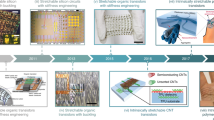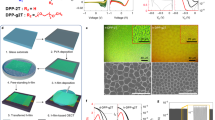Abstract
Intrinsically stretchable electronics can form intimate interfaces with the human body, creating devices that could be used to monitor physiological signals without constraining movement. However, mechanical strain invariably leads to the degradation of the electronic properties of the devices. Here we show that strain-insensitive intrinsically stretchable transistor arrays can be created using an all-elastomer strain engineering approach, in which the patterned elastomer layers with tunable stiffnesses are incorporated into the transistor structure. By varying the cross-linking density of the elastomers, areas of increased local stiffness are introduced, reducing strain on the active regions of the devices. This approach can be readily incorporated into existing fabrication processes, and we use it to create arrays with a device density of 340 transistors cm–2 and a strain insensitivity of less than 5% performance variation when stretched to 100% strain. We also show that it can be used to fabricate strain-insensitive circuit elements, including NOR gates, ring oscillators and high-gain amplifiers for the stable monitoring of electrophysiological signals.
This is a preview of subscription content, access via your institution
Access options
Access Nature and 54 other Nature Portfolio journals
Get Nature+, our best-value online-access subscription
$29.99 / 30 days
cancel any time
Subscribe to this journal
Receive 12 digital issues and online access to articles
$119.00 per year
only $9.92 per issue
Buy this article
- Purchase on Springer Link
- Instant access to full article PDF
Prices may be subject to local taxes which are calculated during checkout





Similar content being viewed by others
Data availability
The data that support the plots within this paper and the other findings of this study are available from the corresponding authors upon reasonable request.
Code availability
The code that supports the results within this paper and the other findings of this study are available from the corresponding authors upon reasonable request.
References
Wang, S. H. et al. Skin electronics from scalable fabrication of an intrinsically stretchable transistor array. Nature 555, 83–88 (2018).
Xu, J. et al. Highly stretchable polymer semiconductor films through the nanoconfinement effect. Science 355, 59–64 (2017).
Chortos, A. et al. Mechanically durable and highly stretchable transistors employing carbon nanotube semiconductor and electrodes. Adv. Mater. 28, 4441–4448 (2016).
Cai, L., Zhang, S. M., Miao, J. S., Yu, Z. B. & Wang, C. Fully printed stretchable thin-film transistors and integrated logic circuits. ACS Nano 10, 11459–11468 (2016).
Kim, H. J., Sim, K., Thukral, A. & Yu, C. J. Rubbery electronics and sensors from intrinsically stretchable elastomeric composites of semiconductors and conductors. Sci. Adv. 3, e1701114 (2017).
Liang, J. J. et al. Intrinsically stretchable and transparent thin-film transistors based on printable silver nanowires, carbon nanotubes and an elastomeric dielectric. Nat. Commun. 6, 7647 (2015).
Zhang, B. et al. Stretchable conductive fibers based on a cracking control strategy for wearable electronics. Adv. Funct. Mater. 28, 1801683 (2018).
Chen, G. et al. Plasticizing silk protein for on-skin stretchable electrodes. Adv. Mater. 30, 1800129 (2018).
Choong, C. L. et al. Highly stretchable resistive pressure sensors using a conductive elastomeric composite on a micropyramid array. Adv. Mater. 26, 3451–3458 (2014).
Qi, D. P. et al. Highly stretchable, compliant, polymeric microelectrode arrays for in vivo electrophysiological interfacing. Adv. Mater. 29, 1702800 (2017).
Miyamoto, A. et al. Inflammation-free, gas-permeable, lightweight, stretchable on-skin electronics with nanomeshes. Nat. Nanotechnol. 12, 907–913 (2017).
Matsuhisa, N. et al. Printable elastic conductors with a high conductivity for electronic textile applications. Nat. Commun. 6, 7461 (2015).
Wang, C. H. et al. Monitoring of the central blood pressure waveform via a conformal ultrasonic device. Nat. Biomed. Eng. 2, 687–695 (2018).
Huang, Z. L. et al. Three-dimensional integrated stretchable electronics. Nat. Electron. 1, 473–480 (2018).
Kim, D. H. et al. Epidermal electronics. Science 333, 838–843 (2011).
Kim, D. H. et al. Stretchable and foldable silicon integrated circuits. Science 320, 507–511 (2008).
Gao, W. et al. Fully integrated wearable sensor arrays for multiplexed in situ perspiration analysis. Nature 529, 509–514 (2016).
Chung, H. U. et al. Binodal, wireless epidermal electronic systems with in-sensor analytics for neonatal intensive care. Science 363, eaau0780 (2019).
Sim, K. et al. Metal oxide semiconductor nanomembrane–based soft unnoticeable multifunctional electronics for wearable human-machine interfaces. Sci. Adv. 5, eaav9653 (2019).
Son, D. et al. Multifunctional wearable devices for diagnosis and therapy of movement disorders. Nat. Nanotechnol. 9, 397–404 (2014).
Liang, J. J., Li, L., Niu, X. F., Yu, Z. B. & Pei, Q. B. Elastomeric polymer light-emitting devices and displays. Nat. Photon. 7, 817–824 (2013).
Trung, T. Q. & Lee, N. E. Recent progress on stretchable electronic devices with intrinsically stretchable components. Adv. Mater. 29, 1603167 (2017).
Oh, J. Y. et al. Intrinsically stretchable and healable semiconducting polymer for organic transistors. Nature 539, 411–415 (2016).
Lacour, S. P., Wagner, S., Narayan, R. J., Li, T. & Suo, Z. G. Stiff subcircuit islands of diamondlike carbon for stretchable electronics. J. Appl. Phys. 100, 014913 (2006).
Graz, I. M., Cotton, D. P. J., Robinson, A. & Lacour, S. P. Silicone substrate with in situ strain relief for stretchable thin-film transistors. Appl. Phys. Lett. 98, 124101 (2011).
Cotton, D. P. J., Popel, A., Graz, I. M. & Lacour, S. P. Photopatterning the mechanical properties of polydimethylsiloxane films. J. Appl. Phys. 109, 054905 (2011).
Libanori, R. et al. Stretchable heterogeneous composites with extreme mechanical gradients. Nat. Commun. 3, 1265 (2012).
Robinson, A., Aziz, A., Liu, Q., Suo, Z. & Lacour, S. P. Hybrid stretchable circuits on silicone substrate. J. Appl. Phys. 115, 143511 (2014).
Romeo, A., Liu, Q. H., Suo, Z. G. & Lacour, S. P. Elastomeric substrates with embedded stiff platforms for stretchable electronics. Appl. Phys. Lett. 102, 131904 (2013).
Cai, M., Nie, S., Du, Y. P., Wang, C. J. & Song, J. Z. Soft elastomers with programmable stiffness as strain-isolating substrates for stretchable electronics. ACS Appl. Mater. Interfaces 11, 14340–14346 (2019).
Wu, Z. G. et al. Seamless modulus gradient structures for highly resilient, stretchable system integration. Mater. Today Phys. 4, 28–35 (2018).
Lee, J. et al. Stretchable GaAs photovoltaics with designs that enable high areal coverage. Adv. Mater. 23, 986–991 (2011).
Cantarella, G. et al. Design of engineered elastomeric substrate for stretchable active devices and sensors. Adv. Funct. Mater. 28, 1705132 (2018).
Cao, Y. et al. Direct fabrication of stretchable electronics on a polymer substrate with process-integrated programmable rigidity. Adv. Funct. Mater. 28, 1804604 (2018).
Liu, Y. Q. et al. Stretchable motion memory devices based on mechanical hybrid materials. Adv. Mater. 29, 1701780 (2017).
Bandodkar, A. J., Nunez-Flores, R., Jia, W. Z. & Wang, J. All-printed stretchable electrochemical devices. Adv. Mater. 27, 3060–3065 (2015).
Gaikwad, A. M. et al. Identifying orthogonal solvents for solution processed organic transistors. Org. Electron. 30, 18–29 (2016).
Hyun, W. J. et al. All-printed, foldable organic thin-film transistors on glassine paper. Adv. Mater. 27, 7058-7064 (2015).
Huang, T. C. et al. Pseudo-CMOS: a design style for low-cost and robust flexible electronics. IEEE Trans. Electron. Dev. 58, 141–150 (2011).
Sekitani, T. et al. Ultraflexible organic amplifier with biocompatible gel electrodes. Nat. Commun. 7, 11425 (2016).
Lee, S. et al. Enhancement of closed-loop gain of organic amplifiers using double-gate structures. IEEE Electron Device Lett. 37, 770–773 (2016).
Lu, G. H. et al. Moderate doping leads to high performance of semiconductor/insulator polymer blend transistors. Nat. Commun. 4, 1588 (2013).
Lussem, B. et al. Doped organic transistors operating in the inversion and depletion regime. Nat. Commun. 4, 2775 (2013).
Lee, C. T. & Chen, H. C. Performance improvement mechanisms of organic thin-film transistors using MoOx-doped pentacene as channel layer. Org. Electron. 12, 1852–1857 (2011).
Liu, Z. Y. et al. High-adhesion stretchable electrodes based on nanopile interlocking. Adv. Mater. 29, 1603382 (2017).
Kang, I., Yun, H. J., Chung, D. S., Kwon, S. K. & Kim, Y. H. Record high hole mobility in polymer semiconductors via side-chain engineering. J. Am. Chem. Soc. 135, 14896–14899 (2013).
Alzetta, G. et al. The deal.II library, Version 9.0. J. Numer. Math. 26, 173–183 (2018).
Yeoh, O. H. Some forms of the strain-energy function for rubber. Rubber Chem. Technol. 66, 754–771 (1993).
Simo, J. C. Algorithms for static and dynamic multiplicative plasticity that preserve the classical return mapping schemes of the infinitesimal theory. Comput. Methods Appl. Mech. Eng. 99, 61–112 (1992).
Acknowledgements
This work is supported by SAIT, Samsung Electronics. R.R., P.K.A. and C.L. acknowledge support from the National Science Foundation through CAREER Award CMMI-1553638. S.-K.K. thanks NRF 2018R1A2A1A05078734. N.M. is supported by the Japan Society for the Promotion of Science (JSPS) Overseas Research Fellowship.
Author information
Authors and Affiliations
Contributions
S.W., W.W. and Z.B. designed the project and experiments. W.W. and S.W. fabricated the intrinsically stretchable transistor array and circuits and carried out the electrical characterizations. S.N. helped with the circuits design and measurements. R.R., P.K.A. and C.L. carried out the mechanical simulations. Y.O. and Y.Z. synthesized the azide compound. W.W. and X.Y carried out the materials characterizations. S.-K.K. provided the conjugated polymer. A.M.F. and R.N helped to take device photographs. N.M., J.X., Y.J. and Z.Z. helped with the experiments design and manuscript preparation. W.W., S.W., Z.B. and J.B.-H.T. wrote the manuscript. All the authors reviewed and commented on the manuscript.
Corresponding authors
Ethics declarations
Competing interests
The authors declare no competing interests.
Additional information
Peer review information Nature Electronics thanks Kyung-In Jang, Rujun Ma and the other, anonymous, reviewer(s) for their contribution to the peer review of this work.
Publisher’s note Springer Nature remains neutral with regard to jurisdictional claims in published maps and institutional affiliations.
Supplementary information
Supplementary Information
Supplementary Table 1 and Figs. 1–23.
Rights and permissions
About this article
Cite this article
Wang, W., Wang, S., Rastak, R. et al. Strain-insensitive intrinsically stretchable transistors and circuits. Nat Electron 4, 143–150 (2021). https://doi.org/10.1038/s41928-020-00525-1
Received:
Accepted:
Published:
Issue Date:
DOI: https://doi.org/10.1038/s41928-020-00525-1
This article is cited by
-
A detachable interface for stable low-voltage stretchable transistor arrays and high-resolution X-ray imaging
Nature Communications (2024)
-
Full integration of highly stretchable inorganic transistors and circuits within molecular-tailored elastic substrates on a large scale
Nature Communications (2024)
-
Motion artefact management for soft bioelectronics
Nature Reviews Bioengineering (2024)
-
Boosting the mobility of organic semiconductors through strain engineering
Science China Materials (2024)
-
High-speed and large-scale intrinsically stretchable integrated circuits
Nature (2024)



